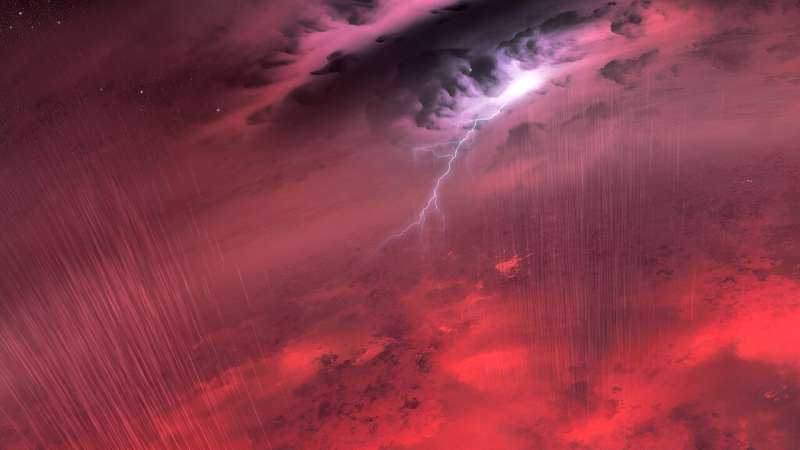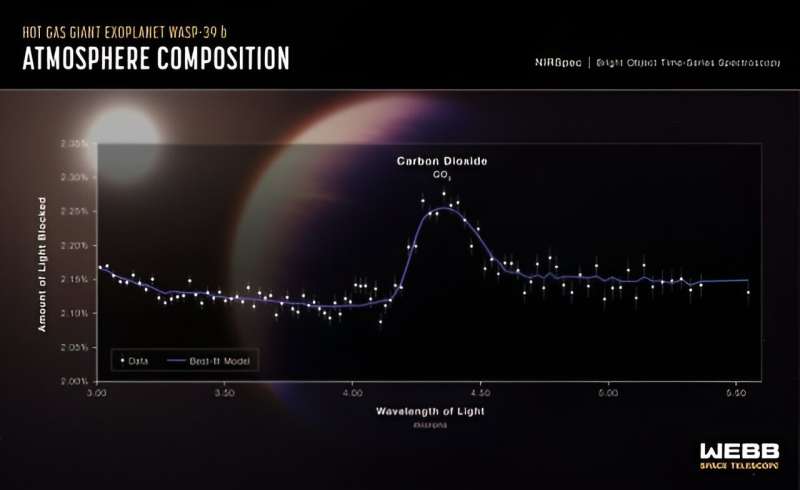This article has been reviewed according to Science X's editorial process and policies. Editors have highlighted the following attributes while ensuring the content's credibility:
fact-checked
peer-reviewed publication
trusted source
proofread
If exoplanets have lightning, it'll complicate the search for life

Discovering exoplanets is almost routine now. We've found over 5,500 exoplanets, and the next step is to study their atmospheres and look for biosignatures. The James Webb Space Telescope is leading the way in that effort. But in some exoplanet atmospheres, lightning could make the JWST's job more difficult by obscuring some potential biosignatures while amplifying others.
Detecting biosignatures in the atmospheres of distant planets is fraught with difficulties. They don't advertise their presence, and the signals we receive from exoplanet atmospheres are complicated. New research adds another complication to the effort. It says that lightning can mask the presence of things like ozone, an indication that complex life could exist on a planet. It can also amplify the presence of compounds like methane, which is considered to be a promising biosignature.
The new research is titled "The effect of lightning on the atmospheric chemistry of exoplanets and potential biosignatures," and it's been accepted for publication in the journal Astronomy and Astrophysics. It is available on the arXiv preprint server. The lead author is Patrick Barth, a researcher from the Space Research Institute at the Austrian Academy of Sciences.
While we've discovered over 5,500 exoplanets, only 69 of them are in the potentially habitable zones around their stars. They're rocky planets that receive enough energy from their stars to potentially maintain liquid water on their surfaces. Our search for biosignatures is focused on this small number of planets.
The important next step is to determine if these planets have atmospheres and then what the composition of those atmospheres is. The JWST is our most powerful instrument for these purposes. But in order to understand what the JWST shows us in distant atmospheres, we have to know what its signals tell us. Research like this helps scientists prepare for the JWST's observations by alerting them to potential false positives and masked biosignatures.
In their research, the authors combined laboratory experiments with photochemical and radiative transfer modeling. Atmospheres can be extraordinarily complex, and no two exoplanets are likely to have the same atmospheric qualities. But physics and chemistry dictate what can happen, and photochemical and radiative transfer models can handle thousands of different types of chemical reactions in atmospheres.
In the laboratory experiments, spark discharge stood in for lightning. The researchers focused on atmospheres containing N2, CO2, and H2 and the different products the lightning produced. Other research has done the same, but this work is different. Previous research focused on either individual products or only a small number of products. But Barth and his colleagues expanded on that work. They studied the production of a wider variety of chemicals.
That allowed them to "… investigate trends in our experiments concerning the oxidation state of lightning products and the influence of water vapor," they explain. "In particular, we were interested in the effect of lightning on the production of potential (anti-)biosignatures in the context of current and upcoming observations of exoplanetary atmospheres."
The researchers found that the effect of lightning on biosignatures depends on the type of atmosphere and the amount of lightning. They looked at two broad types of atmospheres: reducing and oxidizing. A reducing atmosphere has no oxygen or other oxidizing gases and can't produce any oxidized compounds. An oxidizing atmosphere is the opposite. It does contain oxygen, which produces oxidized compounds.

Their results show that for a planet with surface water and habitable conditions with a slightly reducing or slightly oxidizing atmosphere, lightning is less likely to produce false positives. The authors predict that "… for the kind of atmospheres studied here, lightning is not able to produce a false-positive NH3 or CH4 biosignature." They say that it's also unlikely that lightning could produce a false positive N2O biosignature.
But the lightning produced some compounds, including CO and NO. The researchers used the rates of production of both chemicals to calculate how lightning flash rates affect the atmosphere's chemical makeup. Next, they applied that model to Earth-sized planets in the habitable zones of the sun and TRAPPIST-1 for both oxic and anoxic atmospheres. They conducted simulations of those scenarios on planets with and without biospheres. They also calculated the simulated spectra from those worlds to identify chemical signatures.
Their results? "We find that lightning is not able to produce a false-positive CO anti-biosignature on an inhabited planet," the authors explain. "In an oxygen-rich atmosphere, however, lightning rates only a few times higher than modern Earth's can mask the O3 [ozone] biosignature."
But in other situations, lightning can prevent false positives. In an anoxic atmosphere of a planet orbiting an old red dwarf, lightning more frequent than Earth's can remove one type of confounding false positive.
"Similarly, in an anoxic, abiotic atmosphere of a planet orbiting a late M dwarf, lightning at flash rates ten times or more than that of modern Earth can remove the abiotic ozone feature produced by CO2 photolysis, preventing a false-positive biosignature detection," they explain. To say it's complicated is an understatement.
There's yet another twist. Lightning may not prevent other important false positives. "… lightning might not be able to prevent all false-positive O2 scenarios for CO2-rich terrestrial planets orbiting ultracool M dwarfs," the authors write.
Those with an eye for irony might notice some here. Scientists are pretty sure that lightning played a role in life on Earth by providing the energetic spark that got the ball rolling. But the fact that lightning could also make it more difficult for us to discover life is somewhat ironic.
But irony is a human contrivance. Nature doesn't care. It does what it does, and it's up to us to figure it out.
"In summary, our work provides new constraints for the full characterization of atmospheric and surface processes on exoplanets," the authors conclude.
More information: Patrick Barth et al, The effect of lightning on the atmospheric chemistry of exoplanets and potential biosignatures, arXiv (2024). DOI: 10.48550/arxiv.2402.13682
Journal information: arXiv , Astronomy & Astrophysics
Provided by Universe Today





















